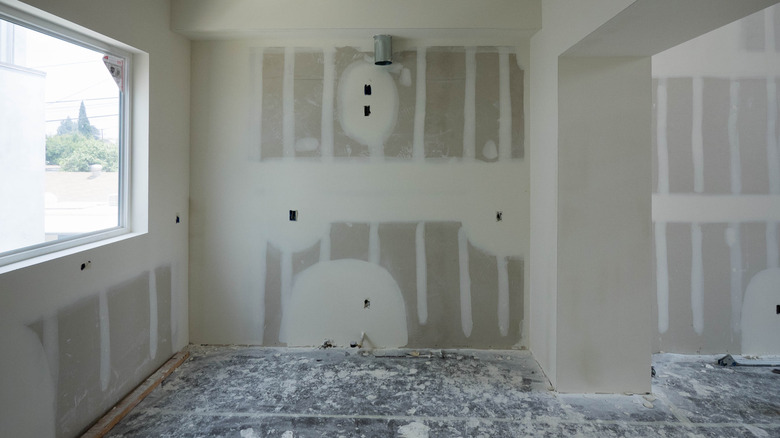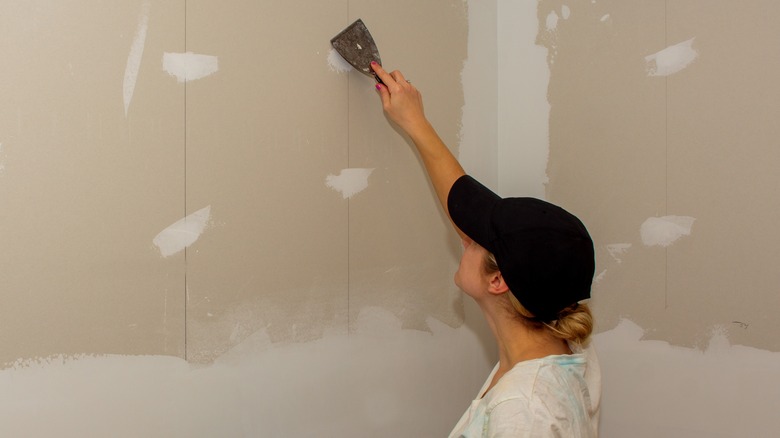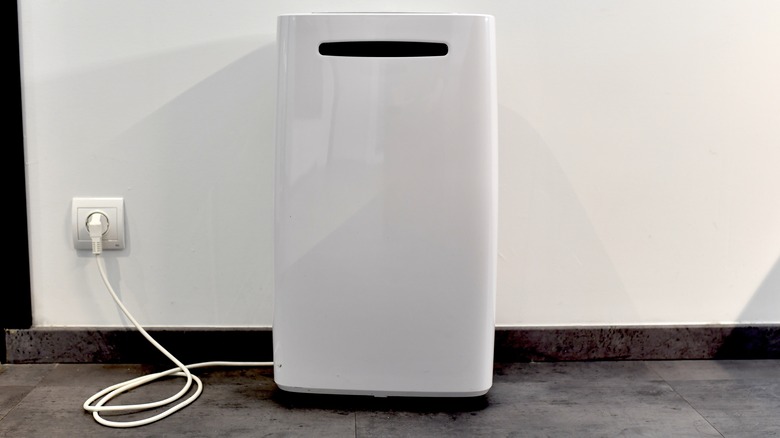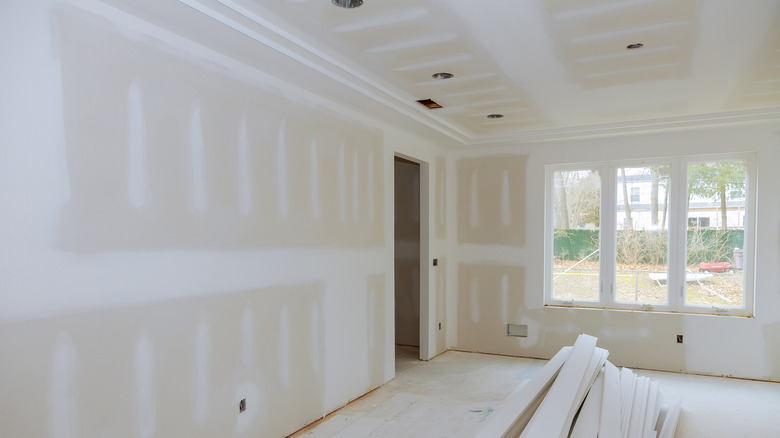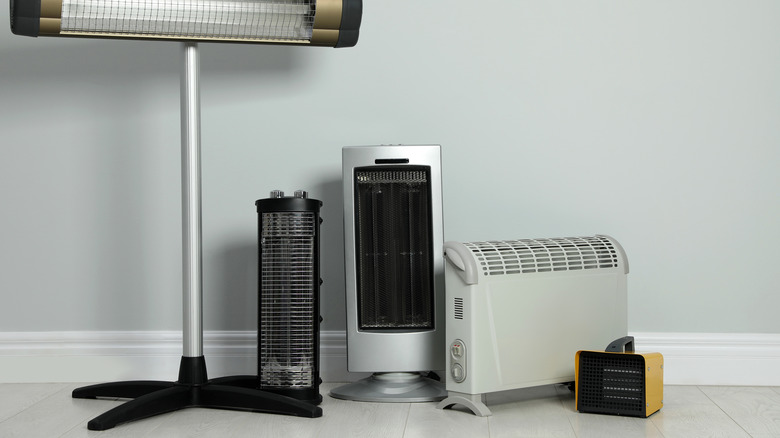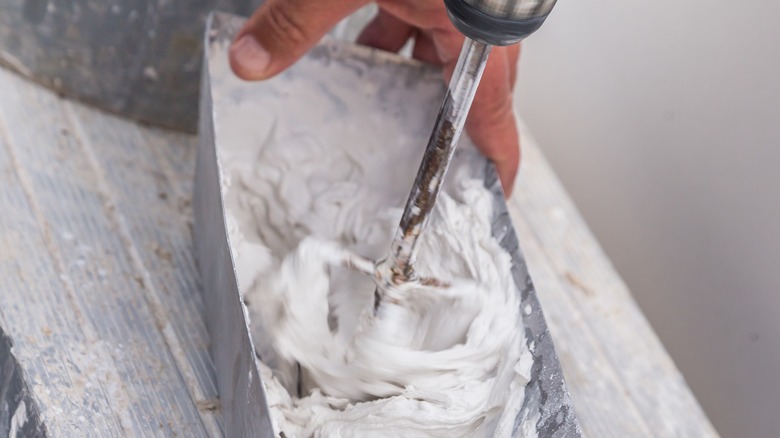5 Tips For Speeding Up Drywall Mud Drying Time
It's exciting to get mud on the walls when you're renovating an area of the home. Mudding is one of the final steps before painting can take place, but before you can do anything else, it has to dry thoroughly. Trying to sand it before it's dry could leave damage to the drywall. BuilderBaron states it generally takes about 24 hours after application for it to dry completely. However, that's dependent on many factors, including how humid it is in the space, how many layers are added, and how well you scraped it down.
You're impatient, though, and you just want to move the project forward and get through with hanging drywall. While it's never OK to move on with the project if the mud isn't dry, there may be a few steps you can take to help it dry out faster. Once it's fully dry, you can sand, prime, and paint over the drywall. How can you help it along?
1. Put on less mud
The thinner the mud is when applied to the surface of the drywall, the less time it will take to dry out. It seems simple enough, but you have to ensure you're still putting on enough of the mud, also known as joint compound, to provide the coverage needed. The mud has to cover all of the uneven areas of the drywall, including all of the screw dimples and any joints where you've used tape to hold the drywall together, according to HGTV. You're going for a smooth surface in every situation.
A thinner application is ideal because it helps create a smoother surface that's less likely to suffer dents if someone brushes into the wall later. You may need to put on more than one thin coat to get to the point of adequate coverage, though. Just be sure to allow each coat to dry fully before applying the next.
2. Reduce the humidity in the space
Moisture in the air is a good thing because it helps keep skin from drying out, but too much of it could slow down your project, especially when it comes to drywall drying. The Chas. E. Phipps Company provides a breakdown showing that humidity is one of the most important factors in the length of time it takes drywall to become dry enough to sand, indicating that it's perhaps one of the most important factors in the equation.
To ensure your drywall compound dries properly, install a dehumidifier in the space and run it throughout the drying process. This will pull much of the moisture out of the space, allowing for the compound to dry out sooner. Be sure to select a dehumidifier that's the proper size for the space you're working in, and then use it according to the manufacturer's recommendations.
3. Boost the ventilation in the space
Another way to speed up dry time is to get air moving in that space. Many times construction sites don't have a lot of ventilation within them, meaning air has a hard time moving through the area. That's especially true when the home's HVAC system isn't operating at the time. Even if you're just updating the drywall in the bathroom, without a significant amount of ventilation and airflow, the drying time will be longer, according to the Walls & Ceilings. Though in larger projects, you'll want to increase ventilation on a larger scale if necessary, in a single-room area, it may be a bit easier.
Consider opening the window if there is one, as long as that doesn't introduce a lot of humidity. You may also want to add a few fans to the space that oscillate, allowing air to move through the space easier.
4. Increase the room's temperature
Turning up the temperature in the room you're mudding can also be a helpful tool to speed up the drying process. Once you have enough mud in place and proper coverage, raise the temperature a few degrees within that space. Unless you're mudding the entire home or no one is living there, it may be best not to use the home's HVAC system to do this.
Instead, Evolving Home recommends the use of space heaters. Be sure to place them in the drywalled room and use them safely according to the manufacturer's recommendations. You should also monitor their use to avoid any risks to the property. You don't need to increase the heat too much, as even a few degrees higher could help to speed up the process, especially when combined with other methods. Combining low humidity with a higher temperature may be the ideal combination.
5. Look into hot mud
Hot mud, or quick setting mud, could be another option if you really don't have a lot of time to wrap up the project. This product comes in a dry form, often in a big bag. Mix up just what you need to avoid wasting a lot of the product. This is a great option when you need to patch drywall and don't need a large amount.
MadDiary states hot mud takes much less time to dry compared to wet, all-purpose joint compound. Instead of taking 24 hours to dry, it typically takes around 12 hours. If it's applied in a thin application, it may take less time than that to dry fully. The downside to this product is that you have to do the mixing of it yourself, which could get messy and could mean a bit more work with your home improvement project.
